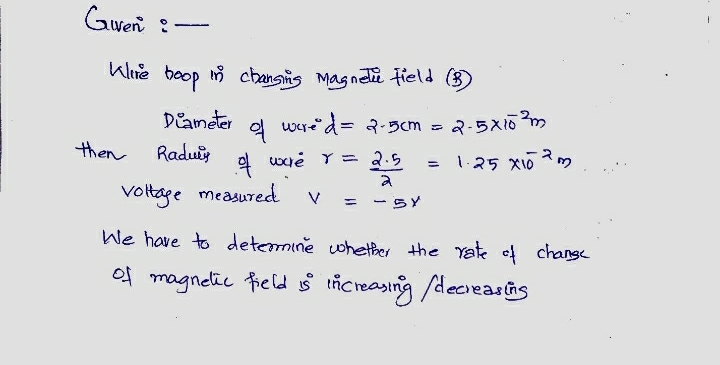[Q12] You place a wire hoop with a diameter of 2.5 cm inside a region of space with a changing magnetic field, and measure a voltage of -5 V. What is the rate of change of the magnetic field, and is it increasing or decreasing?
[Q12] You place a wire hoop with a diameter of 2.5 cm inside a region of space with a changing magnetic field, and measure a voltage of -5 V. What is the rate of change of the magnetic field, and is it increasing or decreasing?
College Physics
11th Edition
ISBN:9781305952300
Author:Raymond A. Serway, Chris Vuille
Publisher:Raymond A. Serway, Chris Vuille
Chapter1: Units, Trigonometry. And Vectors
Section: Chapter Questions
Problem 1CQ: Estimate the order of magnitude of the length, in meters, of each of the following; (a) a mouse, (b)...
Related questions
Question
![**Question 12:** You place a wire hoop with a diameter of 2.5 cm inside a region of space with a changing magnetic field and measure a voltage of -5 V. What is the rate of change of the magnetic field, and is it increasing or decreasing?
### Explanation:
This question involves understanding electromagnetic induction. Given the setup with a wire hoop and a changing magnetic field, you can use Faraday's law of electromagnetic induction to determine the rate of change of the magnetic field:
\[ \text{Voltage} = - \dfrac{d\Phi}{dt} \]
where \( \Phi \) is the magnetic flux through the hoop. The negative sign indicates the direction of induced voltage as per Lenz's law.
To find the rate of change of the magnetic field (\( \dfrac{dB}{dt} \)), you need to calculate the area of the hoop and then solve for \( \dfrac{dB}{dt} \) using the measured voltage.
**Calculation Details:**
1. **Area of the Hoop:**
The diameter of the hoop is given as 2.5 cm, so the radius \( r = 1.25 \) cm = 0.0125 m.
\[ \text{Area} = \pi r^2 = \pi (0.0125)^2 \, \text{m}^2 \]
2. **Magnetic Flux (\( \Phi \)):**
\[ \Phi = B \times \text{Area} \]
3. **Using Faraday’s Law:**
\[ -5 \, \text{V} = - \dfrac{d(B \cdot \text{Area})}{dt} \]
\[ 5 = \text{Area} \times \dfrac{dB}{dt} \]
4. **Solve for \( \dfrac{dB}{dt} \):**
\[ \dfrac{dB}{dt} = \frac{5}{\text{Area}} \]
By calculating the area, you can find the numerical value of \( \dfrac{dB}{dt} \). The negative voltage signifies that the magnetic field is increasing in the direction opposite to the assumed positive directional flux.](/v2/_next/image?url=https%3A%2F%2Fcontent.bartleby.com%2Fqna-images%2Fquestion%2F18d0a7dc-afe1-42e7-9349-84d2cfc69c53%2F52e8cb6a-1e39-4421-8988-2f9b9bf99e88%2F41xb17_processed.jpeg&w=3840&q=75)
Transcribed Image Text:**Question 12:** You place a wire hoop with a diameter of 2.5 cm inside a region of space with a changing magnetic field and measure a voltage of -5 V. What is the rate of change of the magnetic field, and is it increasing or decreasing?
### Explanation:
This question involves understanding electromagnetic induction. Given the setup with a wire hoop and a changing magnetic field, you can use Faraday's law of electromagnetic induction to determine the rate of change of the magnetic field:
\[ \text{Voltage} = - \dfrac{d\Phi}{dt} \]
where \( \Phi \) is the magnetic flux through the hoop. The negative sign indicates the direction of induced voltage as per Lenz's law.
To find the rate of change of the magnetic field (\( \dfrac{dB}{dt} \)), you need to calculate the area of the hoop and then solve for \( \dfrac{dB}{dt} \) using the measured voltage.
**Calculation Details:**
1. **Area of the Hoop:**
The diameter of the hoop is given as 2.5 cm, so the radius \( r = 1.25 \) cm = 0.0125 m.
\[ \text{Area} = \pi r^2 = \pi (0.0125)^2 \, \text{m}^2 \]
2. **Magnetic Flux (\( \Phi \)):**
\[ \Phi = B \times \text{Area} \]
3. **Using Faraday’s Law:**
\[ -5 \, \text{V} = - \dfrac{d(B \cdot \text{Area})}{dt} \]
\[ 5 = \text{Area} \times \dfrac{dB}{dt} \]
4. **Solve for \( \dfrac{dB}{dt} \):**
\[ \dfrac{dB}{dt} = \frac{5}{\text{Area}} \]
By calculating the area, you can find the numerical value of \( \dfrac{dB}{dt} \). The negative voltage signifies that the magnetic field is increasing in the direction opposite to the assumed positive directional flux.
Expert Solution
Step 1

Step by step
Solved in 3 steps with 3 images

Knowledge Booster
Learn more about
Need a deep-dive on the concept behind this application? Look no further. Learn more about this topic, physics and related others by exploring similar questions and additional content below.Similar questions
Recommended textbooks for you

College Physics
Physics
ISBN:
9781305952300
Author:
Raymond A. Serway, Chris Vuille
Publisher:
Cengage Learning

University Physics (14th Edition)
Physics
ISBN:
9780133969290
Author:
Hugh D. Young, Roger A. Freedman
Publisher:
PEARSON

Introduction To Quantum Mechanics
Physics
ISBN:
9781107189638
Author:
Griffiths, David J., Schroeter, Darrell F.
Publisher:
Cambridge University Press

College Physics
Physics
ISBN:
9781305952300
Author:
Raymond A. Serway, Chris Vuille
Publisher:
Cengage Learning

University Physics (14th Edition)
Physics
ISBN:
9780133969290
Author:
Hugh D. Young, Roger A. Freedman
Publisher:
PEARSON

Introduction To Quantum Mechanics
Physics
ISBN:
9781107189638
Author:
Griffiths, David J., Schroeter, Darrell F.
Publisher:
Cambridge University Press

Physics for Scientists and Engineers
Physics
ISBN:
9781337553278
Author:
Raymond A. Serway, John W. Jewett
Publisher:
Cengage Learning

Lecture- Tutorials for Introductory Astronomy
Physics
ISBN:
9780321820464
Author:
Edward E. Prather, Tim P. Slater, Jeff P. Adams, Gina Brissenden
Publisher:
Addison-Wesley

College Physics: A Strategic Approach (4th Editio…
Physics
ISBN:
9780134609034
Author:
Randall D. Knight (Professor Emeritus), Brian Jones, Stuart Field
Publisher:
PEARSON